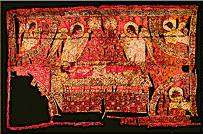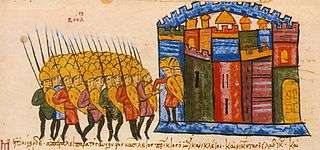Archbishopric of Ohrid
.jpg)
The Archbishopric of Ohrid was an autonomous Orthodox Church under the tutelage of the Ecumenical Patriarch of Constantinople between 1019 and 1767. It was established following the Byzantine conquest of the First Bulgarian Empire in 1018 by lowering the rank of the autocephalous Bulgarian Patriarchate due to its subjugation to Constantinople.
History
Circumstances leading to establishment
In 972, Byzantine Emperor John I Tzimisces conquered and burned down Preslav, capturing the Bulgarian Tsar Boris II. The Patriarch Damyan managed to escape, initially to Sredets. In the coming years, the residence of the Bulgarian patriarchs remained closely connected to the developments in the war between the next Bulgarian monarchist dynasty, the Comitopuli, and the Byzantine Empire. Thus, the next Patriarch German resided consecutively in Moglen, Voden and Prespa. Around 990, the last patriarch, Philip, moved to Ohrid, which also became the permanent seat of the Patriarchate.

History
The Archbishopric of Ohrid was a Byzantine resurrection of the Archbishopric of Justiniana Prima. After 1018 it was the church of the Byzantine Slavs; Bulgarians and Serbs.[1] The Archibishopric was seated in Ohrid, in the Byzantine theme of Bulgaria, and was established in 1019 by lowering the rank of the previously autocephalous Bulgarian Patriarchate and its subjugation to the jurisdiction of the Ecumenical Patriarchate of Constantinople. Although the first appointed archbishop (John of Debar) was a Bulgarian, his successors, as well as the whole higher clergy, were invariably Greeks, the most famous of them being Saint Theophylact of Bulgaria (1078–1107).[1] The Archbishops were chosen from among the monks in Constantinople. Adrian Komnenos, under his monastic name of John, (1143–1160) was the cousin of Emperor John II Komnenos, and was the first Archbishop who held the title of Archbishop of Justniana Prima. The later archbishop John V Kamateros (1183–1216) was a former imperial clerk.
In the 13th and the first half of the 14th centuries, the territory of the Archbishopric was contested by the Byzantine Empire, the Latin Empire, the Despotate of Epirus, the Second Bulgarian Empire and later Serbia. After the fall of Constantinople to the Latins in 1204 and with the foundation of the new states on the territory under jurisdiction of the Ohrid Archbishopric, autonomous churches were founded in the states which did not accept the jurisdiction either of Constantinople or of Ohrid. After 1204, the Empire of Nicaea claimed the Byzantine imperial heritage and provided the refuge of the Greek patriarchs of Constantinople in exile. In the newly founded Second Bulgarian Empire, a new Archbishopric was founded with its see in Tarnovo. Tsar Kaloyan (1197–1207) did not succeed in putting the Ohrid Archbishopric under the jurisdiction of the Tarnovo Archbishopric. Nevertheless, he managed to expel Greek bishops and install Bulgarians instead. The next Bulgarian rulers were constantly trying to make the Ohrid Archbishopric inferior to the Tarnovo Archbishopric. The Latin conquests and the founding of independent Bulgarian and the Serbian states reduced the jurisdiction of the Ohrid Archbishopric immensely, but it did not disappear. During the time of Archbishop Demetrios Chomatenos, the autocephaly of the Archbishopric was confirmed with the act of anointing the despot of Epirus, Theodore Komnenos Doukas, as Emperor and in a correspondence with the Patriarch.
The southward expansion of the Serbian state reached its apogee at the time of tsar Stefan Dushan (1331–1355). The year when Stephan Dushan occupied Ohrid was around 1334. Under Serbian rule Archbishopric of Ohrid kept its autonomy. On April 16, 1346 (Easter) in Serbian capital city of Skopje a joined state and church assembly (sabor) that was held. It was attended by Serbian Archbishop Joanikije II, the Archbishop Nicholas I of Ohrid, the Patriarch Simeon of Bulgaria and other hierarchs and dignitaries, including monastic leaders of Mount Athos. The assembly proclaimed the raising of the autocephalous Serbian Archbishopric to the rank of Patriarchate. The Archbishopric of Ohrid was not annexed to the Serbian Patriarchate of Peć and kept its autonomy, recognizing only the honorary seniority of Serbian Patriarch.[2][3]
After the Battle of Maritsa in 1371, and Battle of Kosovo in 1389, much of the territory of Archbishopric of Ohrid was affected by expansion of Ottoman Turks, who conquered Skopje in 1392 and annexed all southern regions after the death of King Marko in 1395. Archbishopric of Ohrid managed to survive the transition and was legalized by new Ottoman authorities. Not long after the fall of the Bulgarian Patriarchate in 1394, some of the dioceses under its jurisdiction also entered the Ohrid Archbishopric. Thus, in the beginning of the 15th century, the Archbishop of Ohrid, attached the dioceses of Sofia and Vidin to the Archbishopric. In 1408, Ohrid was under Turkish rule. Still, the Turks did not reach after the Ohrid Archbishopric, mostly because of their tolerance for monotheistic religions and left the people to govern themselves regarding religion.
When the last medieval Serbian Patriarch died in 1463, there were no technical options to elect a new one, so the Ohrid Archbishopric had laid its claim over many of the Serbian Patriarchate's eparchies on the basis of its old 1019 territorial rights, predating the 1219 autocephaly. By the 1520s, the Archbishopric of Ohrid had managed to put practically the entire Serbian Church under its jurisdiction, however by intervention of Mehmed-paša Sokolović in 1557, the latter was renewed and reorganized. During the 15th century, dioceses from the other side of the Danube, from the Dukedoms of Wallachia and Moldova, fell under the jurisdiction of the Archbishopric. Nevertheless, this did not last for more than a hundred years. Towards the beginning of the 16th century, the Ohrid Archbishopric expanded its jurisdiction even over territories in Southern Italy, as well as in Dalmatia. The flock of this diocese was made of Greeks and Albanians. Towards the middle of the 16th century, the Ohrid Archbishopric lost the Diocese of Veroia, however, at the beginning of the 17th century, it gained the Diocese of Durazzo from the Ecumenical Patriarchate of Constantinople. Since then and until its abolishment in 1767, the Archbishopric neither lost nor gained a diocese under its jurisdiction.
Abolition
The autocephaly of the Ohrid Archbishopric remained respected during the periods of Byzantine, Bulgarian, Serbian and Ottoman rule and the church continued to exist until its abolition in 1767, when it was abolished by the Sultan's decree, at the urging of the Ecumenical Patriarchate of Constantinople, and was placed under the jurisdiction of the Patriarch of Constantinople.[4] The division into phanariotes and autochthonists which occurred among the diocesan bishops of the Ohrid Archbishopric and, the difficult financial position of the Ohrid Archbishopric over a longer period of time, contributed to its abolishment. Just a year before, the Patriarchate of Constantinople abolished the Serbian Patriarchate of Peć in the same manner, and its dioceses adjoined to the Patriarchate of Constantinople.
Language
The Greek language quite early replaced Old Church Slavonic as the official language of the Archbishopric. All documents and even hagiographies of Bulgarian saints, for example the hagiography of Saint Clement of Ohrid, were written in Greek. Despite this, the Slavonic liturgy was preserved on the lower levels of the Church for several centuries.
Administration
The Archbishopric was under the Ecumenical Patriarch of Constantinople.
The following bishoprics (diocese) are mentioned in 1019:
- Eparchy of Ohrid, eparchy of the archbishop
- Eparchy of Skopje
- Eparchy of Kastoria
- Eparchy of Strumica
- Eparchy of Pelagonia,[5] seat at Bitola
- Eparchy of Velbazhd
- Eparchy of Ras,[6] seat at Stari Ras, formed by 878 (as of 1219 part of Serbian Orthodox Church/SOC)
- Eparchy of Prizren, formed in the 10th century (as of 1219 part of SOC)
- Eparchy of Lipljan, (as of 1219 part of SOC)
- Eparchy of Niš, formed by 343 (as of 13th century part of SOC)
- Eparchy of Braničevo, formed by 878 (as of 13th century part of SOC)
- Eparchy of Belgrade, formed by 878 (as of 13th century part of SOC)
- Eparchy of Syrmia, formed by 300
- Eparchy of Vidin,
- Eparchy of Sredets,
- Eparchy of Drastar, including the Theme of Paristrion (Moesia Inferior)
- Eparchy of Servia, formed in 5th century (as of 1767 part of Ecumenical Patriarchate)
See also
References and notes
- 1 2 https://books.google.com/books?id=UjxpAAAAMAAJ
- ↑ Fine 1994, pp. 309.
- ↑ Ćirković 2008, pp. 64-65.
- ↑ John Shea (1997). Macedonia and Greece: the struggle to define a new Balkan nation. McFarland. p. 173–. ISBN 978-0-7864-0228-1. Retrieved 19 October 2011.
- ↑ Balcanoslavica: Volumes 6-9: "The letters of the archbishop of Ohrid Theophylact from the end of the 11th century sent to the bishop of Pelagonija, as well as the charter of Basil II, show that Bitola was the seat of the bishopric of Pelagonija"
- ↑ The entry of the Slavs into Christendom, p. 208
Literature
- Fortescue, Adrian (1908). The Orthodox Eastern Church. London: Catholic Truth Society.
- Runciman, Steven (1985). The Great Church in captivity: A study of the Patriarchate of Constantinople from the eve of the Turkish conquest to the Greek War of Independence. Cambridge University Press.
- Fine, John Van Antwerp Jr. (1994). The Late Medieval Balkans: A Critical Survey from the Late Twelfth Century to the Ottoman Conquest. The University of Michigan Press.
- Ćirković, Sima (2008). The Serbs. John Wiley & Sons.
- Kiminas, Demetrius (2009). The Ecumenical Patriarchate: A History of Its Metropolitanates with Annotated Hierarch Catalogs. Wildside Press LLC.
- Fine, John Van Antwerp Jr. (2010). When Ethnicity Did Not Matter in the Balkans: A Study of Identity in Pre-Nationalist Croatia, Dalmatia, and Slavonia in the Medieval and Early-Modern Periods. University of Michigan Press.
External links
 Herbermann, Charles, ed. (1913). "Achrida". Catholic Encyclopedia. New York: Robert Appleton Company. The history of Achrida (Ohrid) according to the Catholic Encyclopedia (1913).
Herbermann, Charles, ed. (1913). "Achrida". Catholic Encyclopedia. New York: Robert Appleton Company. The history of Achrida (Ohrid) according to the Catholic Encyclopedia (1913). Herbermann, Charles, ed. (1913). "Bulgaria". Catholic Encyclopedia. New York: Robert Appleton Company. History of Bulgaria and the Bulgarian Orthodox Church according to the Catholic Encyclopedia.
Herbermann, Charles, ed. (1913). "Bulgaria". Catholic Encyclopedia. New York: Robert Appleton Company. History of Bulgaria and the Bulgarian Orthodox Church according to the Catholic Encyclopedia.





